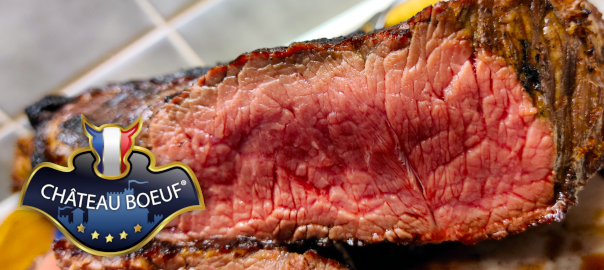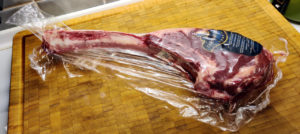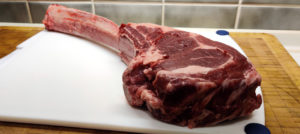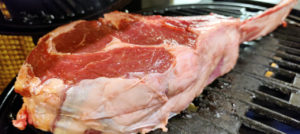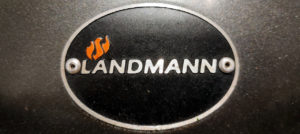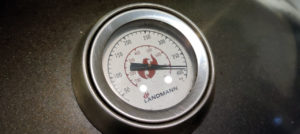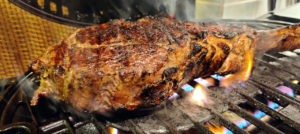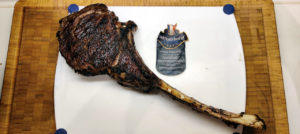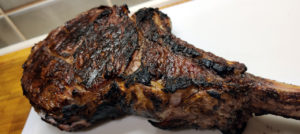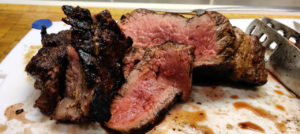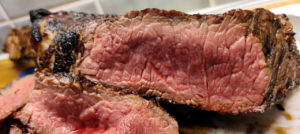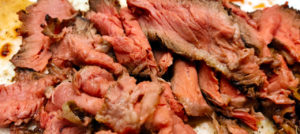The weekend was mighty sunny – reason enough to put up the grill again and “roast” a good piece of meat. Today it was time for the “Family Tomahawk” – here I got myself a great piece of meat from CHÂTEAU BOEUF. The meat of this brand is exclusively available at REWE and it is French premium quality from young bulls.
The “slice” came with a good 1.4 kg – so despite the bones it was enough for the small family – and the price/performance ratio was also right. I had already introduced this interesting European brand to you. The fact that CHÂTEAU BOEUF focuses entirely on family-run businesses, animal welfare and sustainability are reasons enough for me to invest a few extra euros – you can taste the difference!
The impressive steak was vacuum-welded and, according to the labelling, optimally matured by 4 April 2020 – in other words, an exact spot landing. The marbling was already promising and the bright red slice was a good five centimetres thick. As always, I took the meat out of the fridge one hour before use. As soon as it reached room temperature, I made sure that in the end, the whole range of flavours would end up on the plate.
Especially with vacuum-sealed meat, it can be recommended to “free” it from the foil 1-2 days before and then “dry” it open in the fridge (don’t forget to turn it!). Some professional chefs assume that the meat would then taste even more intense and would also be more tender. This is true – but you should also keep in mind that you will need a refrigerator where the meat cannot take on any other aromas. Unfortunately, our domestic refrigerators are always full of other flavours – which can be avoided in the professional kitchen, but then becomes rather difficult at home.
After I removed the foil, I dabbed the tomahawk with some kitchen roll and salted it with fine Himalayan salt a little bit from all sides (including bone). Then I put a few drops of virgin olive oil on the hand and spread this over the whole slice.
As mentioned elsewhere, I almost always abstain from peppering before grilling. The reason for this is that the pepper would burn on the grill and in the worst case the steak would taste slightly bitter – therefore, if necessary, always use the pepper mill at the table.
I had preheated the grill to 400°C and the time had come – I put the slice on the grill.
Close the lid and wait until the temperature had reached 400°C again – which took about 3-4 minutes. Then I opened the grill briefly to rotate the slice a little bit (don’t turn it!) – so I got a nice grill pattern.
It is important that the meat should come off the grill very easily – if it doesn’t, it is still too early. After another 3-4 minutes I turned the steak and after a few minutes I also rotated it a little bit.
After that it was time to turn to the narrow side – the edge of the slice. Of course, this is only possible with the grill lid open. I used grill tongs and a turner and while rotating the Tomahawk step by step I made sure that the typical grill pattern was kept.
According to this, the steak – at least as far as the pressure test (Australian style) was concerned – had reached about the cooking degree “rare”. Since I wanted to have it “medium”, some more cooking time was necessary. So, I grilled it for about 4 minutes at 400°C on each side before I let it rest for about 5 minutes.
Especially this resting phase is essential and provides for the following high pleasure, because only in this way you can make sure that the tasty meat juices remain in the meat when you cut it and don’t end up as “puddles” on the plate! At your next barbecue session, compare it yourself – take a slice that has been resting for 5 minutes and compare it with one that you cut directly from the grill.
With the Tomahawk you have to consider that the slice is composed of several very different areas – that means that these areas will not behave the same during grilling.
You will hardly be able to achieve a result with the tomahawk by just grilling, where the cooking degree of such a mighty slice is the same throughout – just close to the bone it gets tricky. However, if this is important to you, I recommend that you either cook the Tomahawk for at least 1 hour (53°C, medium 56°C) sous vide before you put it on the grill to get the necessary roasting aromas.
Or you can grill it super-hot and then let it cook in the oven (53°C, medium 56°C) – sous vide “backwards”. Advantage, you don’t need plastic bags (even though these are already available today, sustainably and without softeners), but you need an oven that can be tempered exactly.
Personally, I think that it is possible to achieve a good result with a tomahawk even without sous vide. Only when the piece is beyond the 2-3 kg limit, I use Sous Vide from time to time – but then mostly “forward”.
But now back to our “slice”, which has rested enough in the meantime. Because of the high temperatures there is not much left of the grill pattern, but in the cut the steak shows its best side.
The cooking degree is on average about “medium”, whereby some parts vary, which does not detract from the pleasure. There were plenty of roasting aromas, the meat was tender and juicy and we didn’t need any pepper anymore due to the great taste.
We enjoyed the Tomahawk “pure” and it was certainly not the last. This time we even managed to put a small part aside. Later we carved it into fine slices and made a Thai beef salad from it. You can find the recipe in the BBQ corner – just take your beef instead of the Duroc – done.
Enjoy the barbecue and bon appétit!
